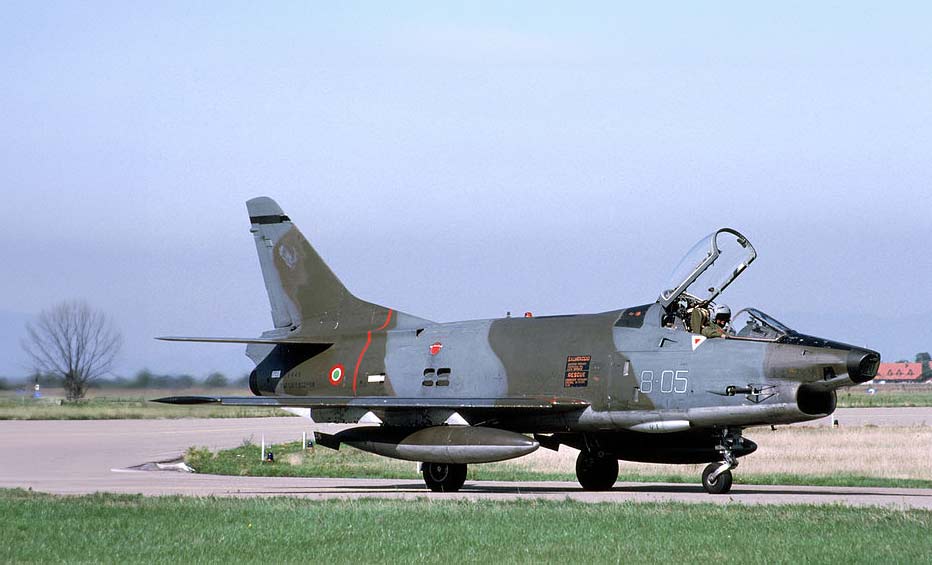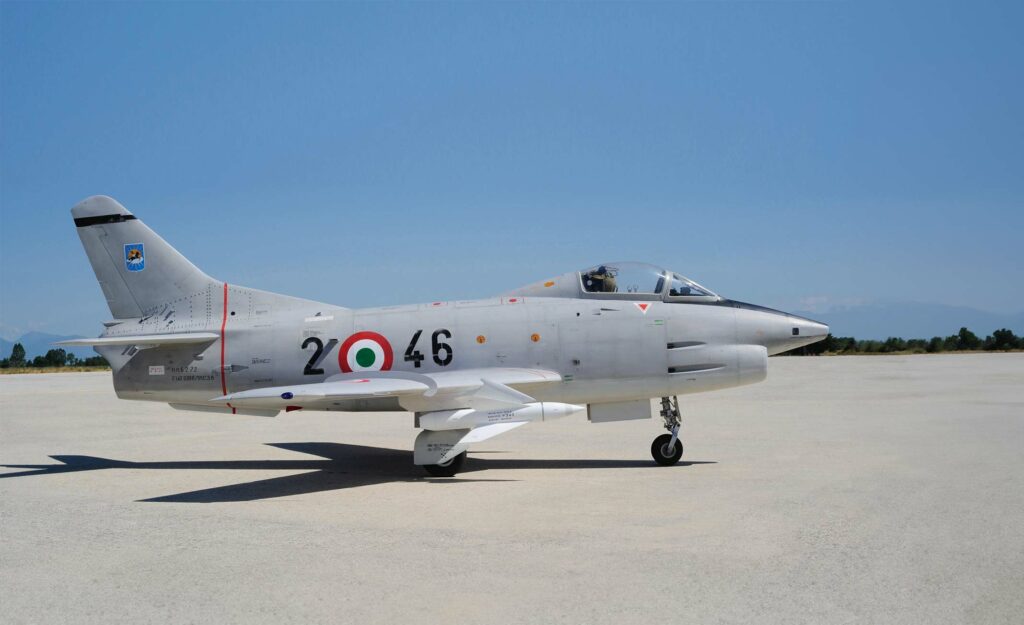The Fiat Aeritalia G.91 is a light, tactical reconnaissance jet and ground-attack aircraft, first flown in 1956, NATO-coded “Gina”.
In brief
The Fiat Aeritalia G.91, nicknamed “Gina,” is a light, single-engine jet designed for reconnaissance and ground-attack missions. Developed in the 1950s by the Italian manufacturer Fiat Aviazione (later Aeritalia), it was selected as the winner of a NATO competition for a light strike fighter. The G.91 is powered by a single Bristol Siddeley Orpheus turbojet engine, providing a balance between speed, maneuverability, and efficiency. It features a robust design with a high-mounted wing and tricycle landing gear, optimized for operations from short and unprepared runways. Its armament includes guns, rockets, and bombs, making it versatile in close air support roles. The G.91 served primarily with the Italian and German air forces and saw action in various conflicts, proving to be an effective and reliable aircraft within its operational parameters.

History of the Development of the Fiat Aeritalia G.91 (Gina)
The development of the Fiat Aeritalia G.91 traces back to the early 1950s, a period marked by the Cold War’s intensification and NATO’s need for a versatile, cost-effective light strike fighter capable of performing reconnaissance, ground-attack missions, and operating from rough, improvised airfields. NATO issued a requirement for such an aircraft, leading to the inception of the G.91 project.
Fiat Aviazione, an Italian aircraft manufacturer, responded to this need by initiating the G.91’s development. The program officially launched in 1953, with the primary objective of creating a light, agile aircraft that could meet the demanding requirements of close air support, reconnaissance, and interdiction missions, aligned with NATO’s strategic needs.
The G.91 first took to the skies on 9 August 1956, a momentous event that marked a significant milestone in Italian aerospace engineering and NATO’s military capabilities. The aircraft’s performance, reliability, and adaptability soon led to its selection as the winner of the NATO competition, earning it a prominent place in the alliance’s air forces.
The nickname “Gina,” though unofficial, became widely used within the aviation community and by the aircraft’s operators. However, the name’s origin is not tied to any NATO designation but rather emerged as an affectionate moniker among those who worked with and flew the aircraft.
The G.91’s development was not just a response to military needs but also reflected the era’s geopolitical tensions and the technological advancements in jet propulsion and aerospace design. It represented a significant step forward for Italy and NATO, demonstrating the capabilities of European aerospace engineering in producing a jet that could hold its own on the global stage.
Design of the Fiat Aeritalia G.91 (Gina)
The Fiat Aeritalia G.91’s design is a testament to the balance between simplicity, functionality, and performance. Its airframe is constructed around a single Bristol Siddeley Orpheus turbojet engine, which generates approximately 5,000 pounds of thrust, propelling the aircraft to speeds up to 685 miles per hour (1,102 kilometers per hour) at sea level. This powerplant was chosen for its reliability, efficiency, and ease of maintenance, critical attributes for an aircraft expected to operate from forward, minimally prepared airfields.
Measuring 33 feet 5 inches (10.2 meters) in length, with a wingspan of 28 feet 6 inches (8.7 meters), the G.91’s compact dimensions contribute to its agility and ease of handling. The aircraft has a maximum takeoff weight of roughly 8,000 pounds (3,630 kilograms), allowing for a significant payload of weapons and fuel without compromising performance.
The G.91 was designed with a high-mounted wing to enhance its short takeoff and landing (STOL) capabilities, a critical feature for operating in the austere conditions expected of a light attack aircraft. Its tricycle landing gear further supports this capability, enabling stable operations on rough terrains.
One of the G.91’s notable design advantages is its simplicity and robustness, which translate into lower maintenance requirements and greater survivability in combat conditions. However, its single-engine design, while reducing complexity and cost, also meant that the aircraft had no redundancy in case of engine failure, a potential drawback in combat situations.
The G.91 brought significant advancements in the design of light attack aircraft, particularly in terms of STOL capabilities, ease of maintenance, and operational versatility. Its design philosophy influenced future generations of combat aircraft, emphasizing the balance between performance, reliability, and cost-effectiveness.
Performance of the Fiat Aeritalia G.91 (Gina)
The Fiat Aeritalia G.91’s performance characteristics solidify its role as a versatile light attack and reconnaissance aircraft. Powered by the Bristol Siddeley Orpheus 803 turbojet engine, the G.91 achieves a maximum speed of 685 mph (1,102 km/h) at sea level, with a service ceiling of approximately 43,000 feet (13,100 meters). Its range is around 620 miles (1,000 kilometers), extendable with external fuel tanks.
This engine configuration provides a thrust-to-weight ratio that ensures responsive handling and agility, crucial for the ground-attack and reconnaissance roles. The G.91’s STOL capabilities allow it to operate from short and unprepared runways, significantly enhancing its operational flexibility.
When comparing the G.91 to its contemporaries, such as the North American F-100 Super Sabre or the Soviet MiG-17, the G.91 stands out for its efficiency and adaptability in low-altitude missions. While it may not match the top speed or high-altitude performance of some competitors, its STOL capabilities, ease of maintenance, and cost-effectiveness make it a valuable asset in tactical support roles.
The G.91’s maneuverability and robust design have proven advantageous in navigating the challenging environments of low-altitude combat, where agility and the ability to quickly engage ground targets are paramount. Its performance profile reflects a well-balanced aircraft capable of fulfilling the diverse demands of reconnaissance and close air support missions.
Variants of the Fiat Aeritalia G.91 (Gina)
The Fiat Aeritalia G.91 series saw the development of several variants, each tailored to specific operational requirements. The initial production model, the G.91R, was designed for reconnaissance and light attack roles, featuring cameras for reconnaissance missions and hardpoints for armaments.
The G.91T variant was a two-seat trainer, retaining the operational capabilities of the single-seat versions while providing the necessary accommodations for pilot instruction. The G.91Y introduced a significant upgrade with a more powerful engine setup and increased payload capacity, enhancing the aircraft’s combat effectiveness.
Each variant of the G.91 series maintained the core design philosophy of simplicity, reliability, and performance, while adaptations were made to meet the evolving needs of the operators. The differences in specifications and capabilities among the variants illustrate the G.91’s versatility and adaptability as a military aircraft.

Military Use and Combat of the Fiat Aeritalia G.91 (Gina)
The Fiat Aeritalia G.91 saw extensive military use, particularly by the Italian and German air forces. Its armament configuration typically included two 12.7mm or 30mm cannons, along with a variety of rockets, missiles, and bombs, making it well-suited for close air support and interdiction missions.
The G.91 participated in several conflicts, most notably during the Portuguese Colonial Wars, where it was employed in ground-attack roles. Its performance in these engagements demonstrated the G.91’s effectiveness in combat, particularly in counter-insurgency operations where precision and adaptability were crucial.
Competing aircraft of the era included the North American F-100 Super Sabre and the Soviet MiG-17, among others. The G.91 distinguished itself through its STOL capabilities and operational flexibility, often allowing it to be deployed in scenarios where other aircraft could not operate effectively.
The G.91 was also sold to several countries, expanding its operational footprint beyond Italy and Germany. Its international use underscored the aircraft’s adaptability to different military doctrines and conditions.
Despite its successes, the G.91 eventually faced obsolescence with the advent of more advanced aircraft technologies. It was phased out of active service in favor of newer models like the Tornado and the AMX International AMX, which offered enhanced capabilities and performance.
The Fiat Aeritalia G.91 “Gina” remains a significant aircraft in the annals of military aviation history. Its development, design, performance, and operational history reflect a period of innovation and adaptation in response to the evolving needs of air combat and reconnaissance during the Cold War. The G.91’s legacy is characterized by its versatility, reliability, and effectiveness in various roles, marking it as a noteworthy contribution to NATO’s air capabilities and to the broader field of aerospace engineering.
Back to the Fighter Jet section.